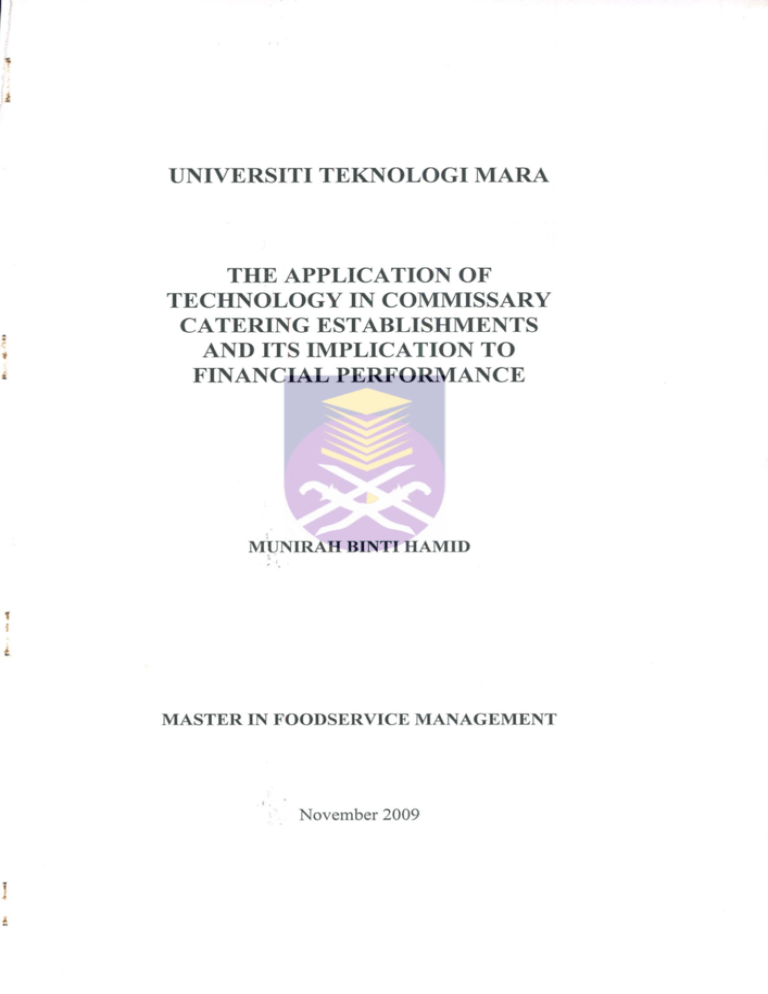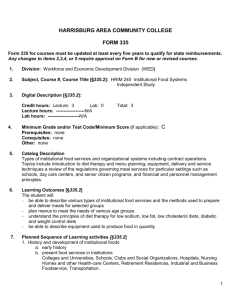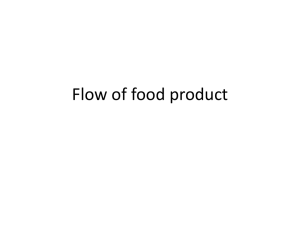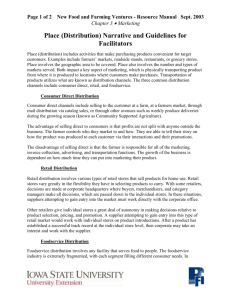- UiTM Institutional Repository
advertisement

UNIVERSITI TEKNOLOGI MARA THE APPLICATION OF TECHNOLOGY IN COMMISSARY CATERING ESTABLISHMENTS AND ITS IMPLICATION TO FINANCIAL PERFORMANCE MUNIRAH BINTI HAMID MASTER IN FOODSERVICE MANAGEMENT November 2009 I I UNIVERSITI TEKNOLOGI MARA $ THE APPLICATION OF TECHNOLOGY IN COMMISSARY CATERING ESTABLISHMENTS AND ITS IMPLICATION TO FINANCIAL PERFORMANCE Munirah Binti Hamid Dissertation submitted in partial fulfillment of the requirements for the degree of Master in Foodservice Management Faculty of Hotel and Tourism Management November 2009 COPYRIGHT © UiTM DEDICATION This thesis is especially dedicated to these special individuals as my inspirations of my life: My ever dearest beloved loving and caring parents, Haji Hamid Haji Saad and Hajjah Ummi Kalsom Abd Flamed My icons and my love that has sacrifices a lot, always giving me encouragements and full of emotion supports, for being so considerate, having patience in me and giving me t freedom and endless love My wonderful sisters, Hilyati and Fadilah Noor My adorable darlings' nephew and niece, Muhammad Azhan Hamizan and Nur Husna Akmalina I apologize for not being able to give all of you my fullest time and attention that I am supposed to give as a daughter, sister and aunt throughout my exhilarating journey for the last one and a half year. However, I promise that I will make it up to those valuable time lost. My only hope is that my success in academic pursuit will make all of you proud and I can be at the same level of success as all of you in my future endeavours. For my nephew and niece, hope that I will inspire and spur you on to even greater heights that I have achieved. I love all of you so much with all my heart. Thank you for all of your endless prayers. May all of you be blessed by Allah S. W. T. Ameen Yaa Rabbal Alameen. 19 L;I COPYRIGHT © UiTM In In Candidate's Declaration I declare that the work in this thesis was carried out in accordance with the regulations of Universiti Teknologi MARA. It is original and is the result of my own work, unless otherwise indicated or acknowledge as referenced work. This topic has not been submitted to any other academic institution or non-academic institution for any other degree or qualification. In the event that my thesis be found to violate the conditions mentioned above, I voluntarily waive the right of conferment of my degree be subjected to the disciplinary rules and regulations of Universiti Teknologi MARA. Name of Candidate Munirah Binti Hamid Candidate's ID No 2008271166 Programme Master in Foodservice Management Faculty Faculty of Hotel & Tourism Management Thesis Title The Application of Technology in Commissary Catering Establishments and its Implication to Ii Financial Performance Signature of Candidate Date 24 November 2009 11 COPYRIGHT © UiTM ABSTRACT Abstract of a thesis submitted in partial fulfilment of the requirements for the Degree of Master in Foodservice Management, Faculty of Hotel and Tourism Management. The Application of Technology in Commissary Catering Establishments and its Implication to the Financial Performance By: Munirah Hamid The importance of technology is undoubtedly denied in most industries with no exception of foodservice industry. This is evident as many food establishments regardless big or small including commissary foodservice systems of adopting technology in their plant. In line with that notion, this study empirically investigates the application of technology in Malaysia commissary catering establishments and to what extent it implicates the financial performance. Triangulation methods which combined the qualitative and quantitative were used in collecting the information. The primarily data was gathered through semi-structured interviews with managers and questionnaire survey with employees of four commissary catering establishments. Result of the interviewed clearly indicated that the application of technology has brought vast benefits to commissary establishments. Technology used not only increased the speed, volume, quality and cleanliness but helped in smooth running of the food production. Despites these, most importantly and the remarkable findings of this study is that the applications of technology has directly boost up the financial performance of the commissary catering establishment. These findings are further supported with quantitative results whereby employees of having the same views with the managers. This study results has given significant indicators not only to those who are already in commissary catering but also to those individuals or companies who intent to venture into this Malaysia so called infant stage in foodservice business. if COPYRIGHT © UiTM ACKNOWLEDGEMENT In my academic pursuit, there is no other tougher experience than when I embarked this thesis which through the entire process of searching, reading, understanding and writing. From initial stage of this journey, I was in total darkness and blind with the uncertainties. Nevertheless, Allah knew what's best for His creation and I always told myself that everything happened with reasons. First and foremost, I thank Allah for giving me the strength, blessing, perseverance and good health which enabled me to complete this study. Alhamdulillah, Allah S.W.T has answered my prayers in getting this "near impossible mission" accomplished. I have also many parties to express my gratitude for providing the much needed assistance. Without acknowledging their contributions it would be serious mistakes. This research would not have been started, nor completed without the financial support from the Universiti Teknologi MARA (UiTM) through a scholarship. My thank goes to my advisor Pn. Roslina Ahmad who made me becomes a true fighter and real survivor through this roller coaster journey. She taught me how to be independent, not to procrastinate and made my spirit stronger than before. My deepest gratitude goes to my superb Assoc. Prof. Dr. Haji Mohd Salehuddin Mohd Zahari as my informal mentor. His pure heart and humanitarian was something that I really admired and saluted. He has offered his generosity and allows me to hang onto him without prejudice. He had opened up my minds to be more critical and be more cautious in my academic writings. He had taught me many things in life, not only the academic part but also the knowledge for the hereafter. Besides his fussiness, firmed and mental torture especially during the process but all those very meaningful for my future career and will be remembered forever. I would always look upon with wonders and admired of his undying spirit, determination and commitment in giving me the best for my research. Jv Fl COPYRIGHT © UiTM Special thanks goes to post graduate coordinator, Dr Salleh Mohd Radzi who had been very supportive and full of consideration and concerned. Same goes to Assoc. Prof. Dr Artinah Zainal and Encik Zulhan Othman for sharing their valuable knowledge and experienced. Appreciation also goes to Syaiful Rizal Jamaluddin, Syauqie Kharip, Andri Nasrun, Khairul Nizam Tafaruddin, Mohd Zulkifli Yaakop, Mohd Helmi Mat Lazi, Shirley Ng and W Adnin Addini Alia W Abdullah for their assistance and contribution during data collection process. My heartfelt appreciation goes to my close friend, my classmate, my future colleague and partner in research Fatimah Abd Ghani. With her I learned the real meaning of friendship and she acts as a sister to me. We have overcome so many horrifying, embarrassing, tormenting experiences throughout our journey. We have cried, laugh, and struggle together, consoled each other, and motivating each other, burning spirit to complete our study in the specific time given. Plus, my deep appreciation goes to her family as allow me to hang on with their wonderful daughter and gave full of supports in finishing this thesis. Not to forget my beloved best friends, Aisyah Zarak Au, Siti Noorshuhada Abdul Aziz, Noorlizawati Jaafar and Wan Fatimah Wan Mohd Nowalid. Their sincere friendship meant a lot to me. Last but not least, a countless grateful goes to my parents, Haji Hamid Haji Saad and - Hajjah Ummi Kalsom Abd Harried for prayers, doa and providing me with an excellent upbringing. Your never failed supports and love is priceless. No matter how great of an - accomplishment I received, nothing compared with love and cherish given by both of you. God Bless you abah and ibu. Munirah Binti Hamid November 2009 V COPYRIGHT © UiTM TABLE OF CONTENTS TITLE PAGE................................... PAGE DEDICATION................................. CANDIDATE'S DECLARATION. 11 ABSTRACT..................................... 111 ACKNOWLEDGEMENT............... iv TABLE OF CONTENTS................. vi LIST OF FIGURES AND TABLES VIII CHAPTER 1 INTRODUCTION .......................................................................................... 1 1 .1 Overview....................................................................................................1 1.2 Background and Issues of Study................................................................1 1.3 Problem in Contextual Setting...................................................................2 1.4 Research Objectives...................................................................................6 1.5 Research Questions....................................................................................6 1.6 Conceptual Framework.............................................................................. 7 1.7 Significance of the Study........................................................................... 7 1.8 Structure of the Study ................................................................................8 1.9 Definition of the Terms..............................................................................9 CHAPTER 2 LITERATURE REVIEW .............................................................................. 10 2.1 Introduction..............................................................................................10 2.2 Commissary Catering Foodservice..........................................................10 2.3 Technology in Foodservice Industry .......................................................16 2.4 Technology and Financial Performance ..................................................18 2.5 Foodservice Industry in Malaysia............................................................19 CHAPTER 3 RESEARCH METHODOLOGY....................................................................24 3.1 Introduction..............................................................................................24 VI COPYRIGHT © UiTM Research Approach, Contextual Setting and Sampling...........................24 Instrument Development..........................................................................25 3.4 3.5 Data Collection Process...........................................................................29 Assessment of Reliability ........................................................................29 CHAPTER 4 QUALITATIVE ANALYSIS AND DISCUSSIONS...........................................31 4.1 Introduction..............................................................................................31 4.2 Commissary Catering Establishments' Profiles ....................................... 31 4.3 Reasons of Applying/Using the Technology ........................................... 33 4.4 Technology and Production.....................................................................35 4.5 Technology Uses and Financial Performance..........................................38 4.6 Quantitative Analysis...............................................................................40 CHAPTER 5 SUMMARY, IMPLICATIONS, LIMITATIONS, 5.1 RECOMMENDATIONS AND CONCLUSION ............................ 43 Introduction........................................................................... 43 5.2 Summary of Findings............................................................ 5.3 Limitations of the Study and Possible Future Research ....... 45 5.4 Implications and Conclusion of the Study............................ 46 Bibliography...................................................... Appendix 1: Guideline Questions for Interview 43 48 Appendix 2: Questionnaire ................................ 55 57 VII COPYRIGHT © UiTM e LIST OF FIGURES AND TABLES Items Page Figure 1.1: Conceptual Framework 6 Figure 2.1: The Food Product Flow for the Type of Centralized (Commissary) Foodservice System 13 Table 3.1: Original Sources of Items Used in the Interview 26 Table 3.2: Original Sources of Items in Section A 27 Table 3.3: Original Sources of Items in Section B 28 Table 3.3: Original Sources of Items in Section C 28 Table 3.4: Alpha Coefficient of Internal Reliability 30 Table 4.1: Commissary Catering Establishments' Profiles 33 Table 4.2: Mean Scores on the Technology's Benefits 40 Table 4.3: Mean Scores on the Relationship between the use of Technology and Production 41 Table 4.4: Mean Scores on the relationship between the use of Technology and Financial Performance 42 viii COPYRIGHT © UiTM CHAPTER 1 INTRODUCTION 1.1 Overview This chapter enlightens on the application of technology in the commissary foodservice system and its implication on the financial performance. It commences by reviewing on It the background of the study and follows by problem statement in the mentioned situational context. Furthermore, research objectives and research questions are tabulated in order to determine direction of the study. Conceptual framework is then constructed whereby independent variables and dependent variables followed by intervening variables. Significance of the study is to see its implication towards the related individuals. Structure of the study is to know the overall of each chapter discussed and reported. It ends by defining selected important definition terms that will make others understand better this study. All of these are interrelated in the consequent sections. 1.2 Background and Issues of Study In this present day, everybody talks about technology. Anywhere and anyplace people are using technology. In fact, human cannot deny the importance of technology in every field. In actual fact, what is technology? In simple word, technology is the process by which humans modify nature to meet their needs and wants. Most people, however, think of technology in terms of its artifacts computers and software, aircraft, pesticides, watertreatment plants, birth-control pills, and microwave ovens, to name a few. But technology is more than these tangible products. According to Merriam-Webster Online Dictionary (2009), technology can be defined as the practical application of knowledge especially in a particular area; a capability given by the practical application of knowledge. Technology can be found widely used in many industries such as agriculture, telecommunication, banking, engineering, and not to forget in the food industry. The food COPYRIGHT © UiTM industry such as restaurants, kitchens and food productions are commonly using technology in their operation. For instance, technologies in food productions constantly believe to increase the productivity in foodservice establishments (Rodgers, 2006). Moreover, the increasing of food production due to the demand from the customers has lead to many food establishments to use technology including commissary foodservice systems. The commissary foodservice system also known as central kitchen, central food production, or food factory or centralizes food production whereby food is prepared and cooked in the central kitchen and transported to satellites (receiving kitchens) where it is served to the customers (National Food Service Management Institute, 2002). One unique characteristic of the commissary foodservice system is that food is transported to external locations (satellite or receiving kitchens) for service. This system would be the best choice availability of labor. Although in the past commissary system involved with the high labor when large numbers of meals are required but the food production is still slow and incapable to meet the high demand (National Food Service Management Institute, 2002). This is evidence when commissary establishment failed to meet the substantial demand of food production (Nonino and Panizzolo, 2007). With the emergence of technology to the industry, many commissary food establishments (Croes & Tesone, 2004) have adopted it in their plant. Rodgers (2006) contended that high volumes of production which require the application of sophisticated foodservice technologies and distribution logistics. She further noted that the application of technology in cooking equipments and preparation techniques tremendously increased the food production (Rodgers, 2008). Creed (2001) on the other hand posit that highly technological in logistic need to be applied when food to be transported. The application of technology in the commissary foodservice system involves high investments to the establishments. This is due to the high cost in the installation of the equipments that often sophisticated and with advanced technological design. In addition to that, food safety and distribution of prepared foods should be concerned with the installation of the advance technological equipment as there are many critical points in 2 COPYRIGHT © UiTM mass food production where the contamination could be occurred. With that, the establishments need to employ a food microbiologist or someone knowledgeable about safety techniques with specialized equipment in mass food handling which is often costly (Palacio and Theis, 2009). They argued that the application of technology in the commissary system is very risky to the establishments if there is no proper research and planning done before applying them to their operation. Rodgers (2007) on the other hand noted that increasing in food production has given a significance impact on the revenue of the establishments. To date, most available studies on commissary system are more concerns on food quality (Hitec, 1994; Luning and Marcelis, 2009); food hygiene and food safety (Worsfold and Griffith, 2003; Amjadi and Hussain, 2005; Rodgers, 2006); productivity (Kumar and Basu, 2008); protective cultures (Rybka et al, 2001; Rodgers, 2003); skills and responsibilities (Baum, 2006). Beside those studies, there are also researches on supply, development and/or commercialization of new technologies has been studied (Chesbrough and Crowther, 2006; Maula, Keil and Salmenkaita, 2006; Vanhaverbeke and Cloodt, 2006). Nevertheless, there are only few studies looked into the relationship between the application of technology in the hotels and their financial performance (Sharma and Upneja, 2005; Orfila-Sintes and Mattsson, 2007) and none has looking from commissary catering prospective. In fact, no such research available in Malaysian context. Having discussed on the study gap, the subsequent section discussed the issue related to the present study which is focusing on commissary establishment in Malaysia. 1.3 Problem in Contextual Setting Commercial Foodservice in Malaysia plays an important role in contributing income to the country as the revenue forecasted will be increased from RM 38, 064 million in 2005 to RM 40, 550 million in 2006 (Ministry of Finance, 2006). According to Euromonitor (2006), the number of commercial foodservice outlets grew by nearly four percent in n -1, COPYRIGHT © UiTM 2004, to reach over 23, 046 from 22, 266 units in 2003. Commercial foodservice operations are designed to earn revenues in excess of expenses so as to provide a financial return to investors and owners. Key segments of the commercial category are eating and drinking establishment. One of the segments in commercial foodservice is chained restaurant, such as fast food and pizza full service (Euromonitor, 2006), which continue to be the fastest growing and strengthening their presence. Chained fast food outlets accounted for more than 96 percent of the 1375 fast food outlets in 2004 compared to independent outlets. In line with these notions, many of foodservice establishments have implementing commissary foodservice system to fulfill the demands from the customers. Similar to other foodservice system, technology advancement is also applying in many commissary productions in this country. The commissary foodservice in Malaysia is used in wide array of establishments such as airline foodservice, catering foodservice, and hospital/healthcare foodservice. In airline foodservice for instance, there is a central production facility on or nearthe airport property where the food is prepared, pre-plated, sealed, and either chilled or frozen. The pre-plated meals are placed in closed carts, and the trays with the cold items are assembled and placed in closed carts. These carts are transported by truck to the airplane (satellite), where the food is placed in the galley. The plates requiring rethermalization are placed in convection ovens by the caterer. Once the airplane is airborne, the stewards assemble and distribute meals. Assembly usually only consists of placing the passengers' choice of hot entrée on the tray that contains all of the cold items. Once the airplane lands at its destination, the caterer sends a truck to the airplane to get the used carts, trays, and dishes and returns them to the central food production facility for washing and sanitizing. At the same time, the airplane is supplied with the meals required for the next flight. On the same note, manyfat food restaurants and casual restaurants are also using commissary foodservice system in their operation. Mc Donalds, Secret Recipe, and Delifrance are the examples of it. In the commissary kitchen, the technology involves are related to storing, preparation techniques, cooking equipments, and logistics (distribution). For instance, the technology COPYRIGHT © UiTM in storing such as blast chiller and freezer are a must in every large commissary establishments. Likewise, the steam jacketed kettle and tilting pan are examples of the equipments that involve of technological advance in the commissary operation. The implementation of technology in many commissary establishments is probably because it increases the productivity, quality, safety as well as hygiene and cleanliness. In addition, the adoption of advancement technology in many production facets is believed to reduce the operation and labor cost despite, these technologies applied requiring high cost of the initial investment and maintenance by the establishments. Besides reducing the cost, it could be also argued that the implementation of technology in the commissary kitchen with the intention to increase the financial performance. Based on the previous study undertaken in oversea the application of technology in the hotels and fast food restaurants has given significant impacts to their financial performance (Sharma and Upneja, 2005). Nevertheless, there is no reported study on catering commissary kitchen related to the financial performance available in Malaysia. In other word to what extent that the application of technology in catering commissary system improves the establishments' financial performance is not known or widely research. Therefore, this study is to examine the stated matter I 5 COPYRIGHT © UiTM 1.4 Research Objectives In regards from the previous mentioned matters, this research is to investigate to what extent the application of technology influence the financial performance in catering commissary foodservice system in Malaysia. This main objective is further supported by four sub-objectives: ROt: To examine the reason of using technology in catering commissary foodservice system. R2: To identify whether the uses of technology increase the production in catering commissary foodservice system. R3: To investigate to what extent the technology uses increase the financial performance in catering commissary foodservice system. 1.5 Research Questions After research objectives have been developed, the researcher need to formulate several research questions to clear up the direction of the study. In relation to that, four research questions are formulated. RQ1: What is the reason of using technology in catering commissary foodservice system? RQ2: How far the uses of technology increase the production in catering commissary foodservice system? RQ3: To what extent the technology uses increase the financial performance in catering commissary foodservice system? COPYRIGHT © UiTM 1.6 Conceptual Framework Further supporting the direction of the study, the conceptual framework which shows the relationship between the variables interest is illustrated. Independent Variable Moderating Variable Uses of Technology S • Preparation techniques • Cooking equipments • Storage • Logistic Production Dependent Variable Financial performance in Commissary Catering Establishments • Speed • Volume • Quality • Cleanliness Figure 1.1: Conceptual Framework 1.7 Significance of the Study The significant of this study can be looked from two aspects. On the theoretical aspects, this study will provide some useful insight to the foodservice organizations on the benefit of the application of the technology particularly in the catering commissary system. On the other hand, this also would help catering commissary operators whether worth to invest the use of technology in their operation. Result of the study also will supports and assists the foodservice operators, restaurateurs and caterers in bolstering the efficiency and productivity in their food production with the application of technology. In addition, this study indirectly will educate particularly the catering commissary managers to understand technology advancement which can be applied to their plant. 7 COPYRIGHT © UiTM From the academic perspective, this study would extend and expand the body of knowledge and literature in the application of technology in the catering commissary system and its implication on financial performance. In addition, this study also provides a benchmark and basis for future direction of other potential studies in this realm. 1.8 Structure of the Study The structure of the study is arranged as follows and is position on five important components represented as the chapters. The introductory chapter identified and discussed the relevant issue or the problem setting related to the topic of concern. A conceptual framework and the specific objectives and questions involved with this study are also included in this first chapter. Chapter Two then reviews the relevant literatures to the subject matter of the study and this is discussed and argued between various researchers. The first section elaborates the understanding on the concept of commissary catering foodservice system. This is followed (section two) by the explorations on the technology in the foodservice industry. The relationship between technology and financial performance is reviewed in the section three. Section four ends the chapter by reviewing the previous studies relating the Malaysian foodservice industry. Furthermore, for Chapter Three, it presents the analyses of the study. The respondents' profiles and the three research objectives are described in this chapter. The research approach, method and survey employed in this study are described. Here guideline for interviews and questionnaires are designed corresponding to the conceptual framework of the research. Moreover, the informative records are analyzed after obtaining from interviews. Likewise, data obtained from respondents are evaluated after keying by using SPSS. Results of the surveys are then shown and interpreted and presented in Chapter Four. A summary of the findings and implications, as well as limitations and recommendations 8 COPYRIGHT © UiTM for the future research are presented in Chapter Five. Besides that, the researcher tries to give some suggestions on how the conclusion can be applied in management practice, as well as bring forward some research limitations. List of bibliographies and references used for this research and appendices are also included for future use. 1.9 Definition of Terms 1. Technology - the practical application of knowledge especially in a particular area; a capability given by the practical application of knowledge (MerriamWebster Online Dictionary, 2009). 2. Commissary System - a central production kitchen or food factory with centralized food purchasing and delivery to off-site facilities for final preparation (June Payne Pallacio, 2005). 3. Financial Performance - a subjective measure of how well a firm can use assets from its primary mode of business and generate revenues. This term is also used as a general measure of a firms overall financial health over a given period of time, and can be used to compare similar firms across the same industry or to compare industries or sectors in aggregation. (Investopedia, 2009). 4. Productivity - a measure of output from a production process, per unit of input. For example, labor productivity is typically measured as a ratio of output per labor-hour, an input. (Wikepedia, 2009). It is often measured in financial a term that is as the relationship of the cost of production versus sales revenue generated. (Clark, 1997). 5. Speed of Production - Speed is the rate of motion, or equivalently the rate of change of distance. Speed is a scalar quantity with dimensions length/time; the equivalent vector quantity to speed is velocity. Speed is measured in the same physical units of measurement as velocity, but does not contain the element of direction that velocity has. Speed is thus the magnitude component of velocity. 9 COPYRIGHT © UiTM 7 CHAPTER TWO LITERATURE REVIEW 2.1 Introduction This chapter begins with the literatures related to the commissary catering foodservice system. The reason of looking at this is to gain a better understanding on the nature of this system in the food service industry. This is discussed in the first section of this chapter. As the application of technology is important in any foodservice operation, the review on this matter is highlighted and discussed in the section. Subsequently, the relevant past studies related to the financial performance are reviewed in the third section of this chapter. This is follow with the scenario of Malaysian Food service industry which is discussed in the final section of this chapter. 2.2 Commissary Catering Foodservice Before we proceed on the commissary catering foodservice, it is vital first to discuss and understand the types of foodservice system. According Payne-Palacio and Theis (2009) t. the foodservices that operate in similar manner, or common elements can be grouped into specific types of systems depending where the food is prepared in relation to where as it & served, the time span between preparation, and service, the forms of foods purchased, methods of holding prepared foods, and the amount and kind of labor and equipment required. They named four types of foodservice systems which are conventional, readyprepared (cook/chill or cook/freeze), assembly/serve and commissary (central production kitchen). According to National Food Service Management Institute (2002), the most common foodservice system is a conventional foodservice. In this system, ingredients are assembled and food is produced onsite, held either heated or chilled, and served it to the 1D COPYRIGHT © UiTM customers. Food is purchased all along the food processing continuum. For example, some items may be purchased from the end and require full preparation. Other items may be purchased with some processing, while others may be purchased fully prepared, only requiring portioning and service. Usually, the conventional foodservice systems are used extensively in schools, restaurants, colleges and universities, and cafeterias. Because of the current labor shortage, many of these conventional foodservice systems are using more and more food products from the complete end of the food processing continuum. In ready - prepared foodservice system, food is produced onsite, held chilled or frozen, reheated, and served to customers on site. Food production can be scheduled at any time, since food is prepared and stored frozen or chilled for later rethermalization and service. This system also allows multiple-day production to be done at one time. For example, if chili is on the menu two times in the next 30 days, the total amount of chili can be made at one time, which reduces labor costs. In this system, food is purchased all along the food processing continuum. Some items for instance may be purchased from none end, and require full preparation. Soups, entrees, casseroles, and sauces would likely be fully prepared on site from ingredients purchased at none end of the food processing continuum. Other items may be purchased with some processing, while others may be purchased fully prepared, only requiring portioning and service (National Food Service Management Institute, 2002). The term "kitchenless kitchen" as other name implied to the assembly-serve foodservice IN system. This is owing to no on-site food production are required. According to PaynePalacio and Theis (2009), many of foodservice establishments confronted with high labor costs and few skilled employees turned to this system to relieve the labor situation. Often with this system, "single-use" disposable tableware is used, thus eliminating the need for a dishwashing unit. National Food Service Management Institute (2002) on the other hand explained that there are many choices in foods that can be purchased that only require heating and serving. In addition, the food in this system is purchased at the middle to complete end of the food processing continuum. The purchased food is then * 11 COPYRIGHT © UiTM can be stored either frozen or chilled for later use. It is later can be portioned, reheated, and served to customers. The last type of foodservice system is recognized as commissary foodservice. It is also known as central kitchen, central food production, or food factory that centralizes the food production. According to National Food Service Management Institute (2002), in commissary foodservice system, the food is normally transported to satellites (receiving kitchens) where it is served to customers. In addition, the Institute explained that the food usually is purchased near the none end of the food processing continuum and food preparation is done in the central kitchen, which results in lower food costs (National - Food Service Management Institute, 2002). This can clearly be seen in Figure 2.1. PaynePalacio and Theis (2009) argue that labor costs are lower in this type of system because of the centralization of food preparation. They further argue that this foodservice system takes advantage of economies of scale, so it is most effective when mass food production is required. Kahraman, Cebeci and Ruan (2004) on the other hand described that the commissary system as a large, central production kitchen with centralized food purchasing and delivery of prepared foods to service (satellite) units located in separate, remote areas for final preparation and service. They further contended that typical users of this system are airline caterers, large city school systems and franchised or chain restaurant organizations that provide food for their various outlets and vending companies. One unique characteristic of the commissary (centralized) foodservice system is that food is transported to external locations (satellites or receiving kitchens) for service (Kahraman, Cebeci and Ruan, 2004). These researchers noted that two factors need to be considered about the transported food are temperature and packaging. Food can be transported both cold or hot, which impacts the delivery and the equipment needs in the receiving kitchens and in transportation. The food can be sent to the receiving kitchens bulk or pre-plated, which impacts the equipment and labor needed at the receiving 12 COPYRIGHT © UiTM kitchen. In addition, food production and delivery schedules must be coordinated (PaynePalacio and Theis, 2009). FOOD PROCESSING CONTINUUM 'II S - ilone CENTRALIZED FOODSERVICE SYSTEM FOOD PRODUCTION STORE CHILLED STORE FROZEN a RECEIVING KITCHEN RECEIVING KITCHEN RECEIVING KITCHEN HOLD HEATED RECEI\!ING KITCHEN RECEIVING KITCHEN SERVE TO CUSTOMERS SERVE TO CUSTOMERS 1 SERVE TO CUSTOMERS SERVE TO CUSTOMERS SERVE TO CUSTOMERS Figure 2.1: The food product flow for the type of centralized (Commissary) foodservice system S 13 COPYRIGHT © UiTM NG Minor and Cichy (1996) enlightened that the commissary foodservice systems are characterized by food production in a central location with distribution to the service outlets. This foodservice system has proliferated because of technological developments in production equipment. They further noted that expensive multifunction equipment is often required in the commissary for preparation of foods from the unprocessed state. Besides that, they noted the space requirements at the service sites are minimized because only limited production equipment is required. Most recent researchers unanimously agreed that the commissary foodservice system is also referred to commissary catering system (Clark, 1997; Creed, 2001; Wilson, Murray and McKenna-Black, 2001; Worsfold and Griffith, 2003; Kahraman, Cebeci and Ruan, 2004; Riley, 2005; Chow, Lo, Sha and Hong, 2006). Kahraman, Cebeci and Ruan (2004) for instance argued that the aim of commissary catering systems developed over recent years is to overcome the problems of skilled labor shortage and reducing operational costs by industrializing the catering operation. They further added that catering is primarily concerned with the provision of meals, food and refreshments fully prepared away from people's homes. Davis, Lockwood and Stone (2006) stated the commissary catering industries have diversely spreads into many segments in the foodservice organizations. This is including the fast food catering, industrial catering, function catering, hospital catering, airline catering and school catering and many more. Walker (2006) in fact argued that the food and beverage division of a hotel that is responsible for arranging and planning food and beverage functions for conventions is also consider as commissary catering. Based literature, there were various studies relating to commissary catering foodservice (Crow, 1995; Silverstone, 1995; Eves, Corney, Kipps, Noble, Lumbers and Price, 1996; Wilson, Murray and Black, 2000; Kivela, Lam and Inbakaran, 2002; Rodgers, 2003; Guilland, 2003). Crow (1995) looked into the quality and value for money produced commissary kitchen in the prison. He explained that the food is obviouly a critical factor in prison life and described this element as an "essential core service". The researcher lT1 COPYRIGHT © UiTM






